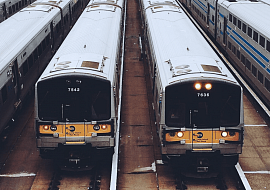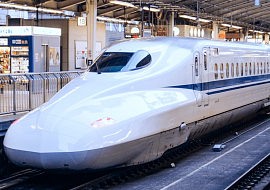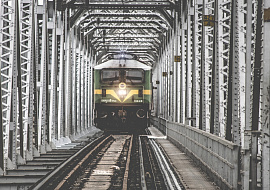Communications-Based Train Control: From Basics to Implementation
It took time for the Communications-based train control (CBTC) to become an implicit standard for the modern signaling systems design. Yet today CBTC is a key driver of the unmanned trains’ increasing adoption worldwide. It allows not only to dream but also to plan the global introduction of GoA4-enabled transportation providing unprecedented safety levels.
For now, the technology is mature enough to ensure minimized risks associated with its implementation. In practice, the commissioning phase hardly ever starts as scheduled initially through a substantial scope of work, amount of equipment, parties involved, and budgets proposed. However, Communications-based train control now is not exactly the same as introduced 15 or 20 years ago. The concept and system architecture have kept their relevance, but now we have much wider capabilities through technological breakthroughs and best practices accumulated. How to harness them reasonably? Let’s have a deep dive into CBTC.
Fundamentals for Communications-Based Train Control
Communications-based train control provides an approach to the rail signaling system design, which involves ongoing train–wayside–dispatch communication for the automatic assignment of Movement Authorities based on train position and other specific features. Under CBTC standards, the train communicates its exact location in real-time, enabling dynamic calculation of the minimal safe separation distance between the train in front according to its braking curve and speed limitations.
This vehicle-centric approach releases from fixed blocks and artificial train separation, as well as reduces the share of human involvement, which resulted in:
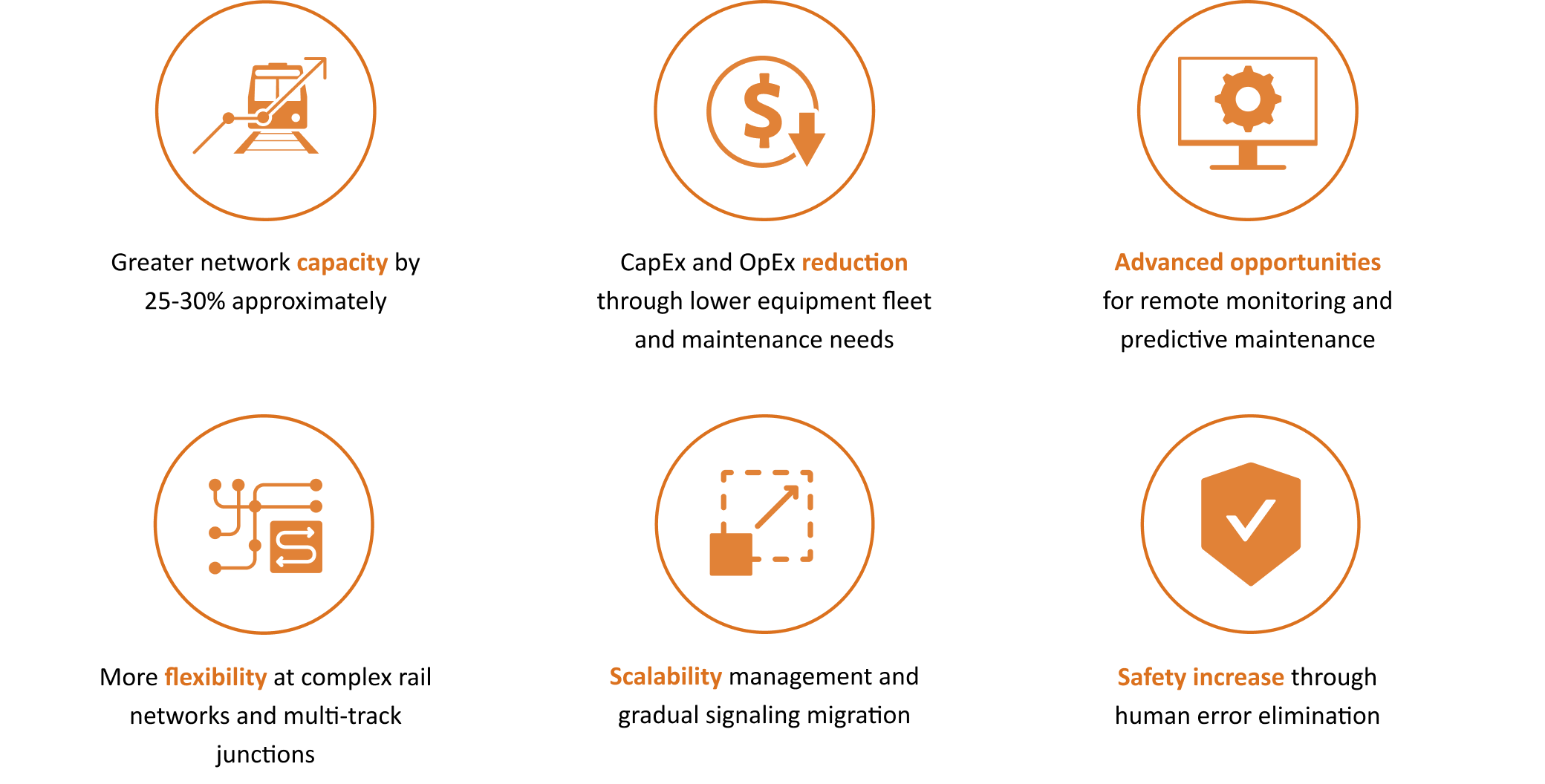
Thus, Communications-based train control became a groundbreaking technology for high-speed rail lines enabling higher ridership and potentially limitless speed. It remains the most demanded technology for fully automated metro operation under GoA4. As per 2018 statistics, 87% of the driverless metro lines introduced in the last decade worldwide are CBTC-based and serve a capacity of 300 to 700 passengers per train. The study predicts their mileage will increase four-fold by 2028. Such high hopes are put on Communications-based train control, and such significant challenges still stand in the way of its extensive adoption.
CBTC at a Glance: End-to-End Architecture
Compared to other cutting-edge signaling systems vigorously developing around the world, Communications-based train control is the most comprehensive one maintaining ultimate coherence between all the subsystems.
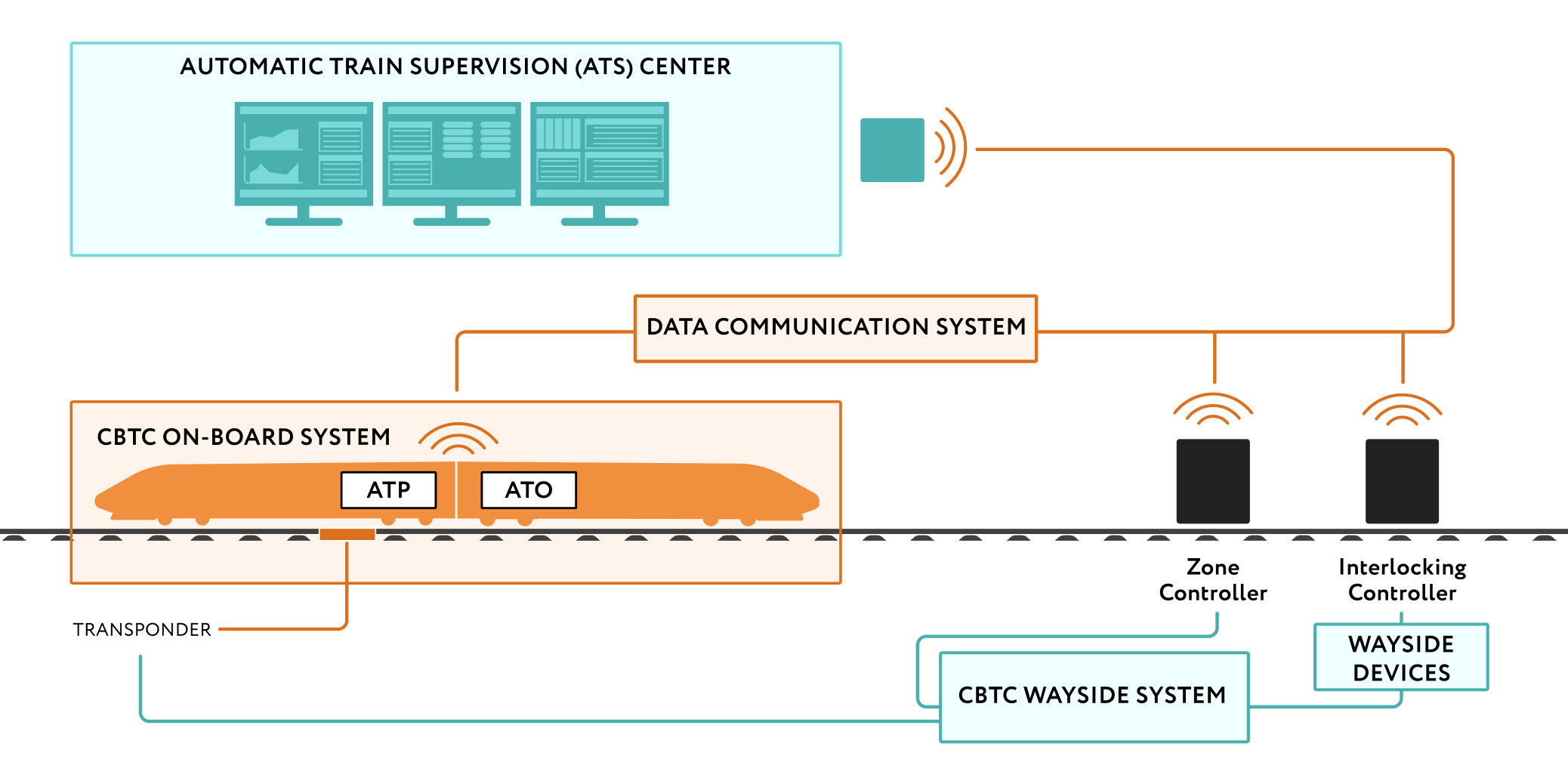
After CBTC introduction, its functionality has to be configured appropriately for the following components:
Zone controllers to provide train detection and calculation of the safety distance, as well as determination of Movement Authority for all within an assigned area, and providing temporary speed restriction. Interlocking controllers to manage wayside devices, such as switchers and signals.
ATP/ATO shall provide ultimately safe movements under Movement Authority determined by wayside controllers and guarantee that all required train features and regulations are considered for the speed profile.
ATS subsystem provides a user interface for dispatchers and ensures automatic traffic coordination through train detection, tracking, routing, and executing a station stop.
System to ensure continuous, high-speed, two-way critical communications, providing a medium between all the subsystems for their coherent operation.
CBTC naturally goes beyond bare signaling control and requires advanced supervision and direct carborne communication to automate train operations. ATP and ATO subsystems are not obligatory under Communications-based train control, but anyway, it has to operate in cohesion with them to provide instantaneous speed adjustment and train stop.
Communications-Based Train Control for Signaling Modernization – Harnessing the Best Practices
Whether it comes to CBTC design for the newly-built line or modernizing the existing rail network with Communications-based train control, you have a similar scope of considerations and challenges, unless modernization requires a deeper focus on interoperability between conventional and CBTC systems. CBTC migration involves the comprehensive redesign of the signaling system for the rail network or specified rail sections with correspondent equipment replacement and significant adjustments for the related subsystems. To alleviate CBTC challenges during the whole system lifecycle, it’s worth considering best practices already before starting design activities.
Today, best practices are seen in the balance of a deep human expertise, and all the technology-related innovations and measures. Despite the rail market being quite closed and knowledge and technology transfer limitations, we should provide deep investigations into every new opportunity to make the most out of the increasingly innovative nature of Communications-based train control. In this way, striving for a balance between safety-focused development and time and budget compliance would increase trust in CBTC systems and streamline the process of CBTC project approval.
Focus on Initial Activities with Communications-Based Train Control Project
When handling rail networks, we handle extensive objects that may have a 150+ year history comprising multiple upgrades, and poor documentation maintenance. Hardly any Book of Plans fully reflects the situation on the field, which calls for rigorous documentation reviews and regular reconciliation onsite to launch design scope. Otherwise, the project risks facing unplanned activities, re-ordering, or under-ordering the equipment, which prolongs the project and leads to budget drawbacks. Such a tiny detail as unmarked modernization or missing contacts may delay the project for half a year through time-consuming manufacturing of complex and highly specified wayside equipment. It’s also critical to timely communicate changes to all the involved parties to eliminate extra work and redesign activities.
Signaling experts have to meticulously investigate inconsistencies, require validation, and upgrade the initial documentation. If we neglect the latter, this issue will arise again with further updates. So, documentation due diligence is the groundwork to proceed with any signaling design activities.
CBTC-Focused Signaling Engineering: Tie-ins and Determination
Despite CBTC-enabled signaling design following the same rules as conventional signaling regarding circuit diagrams development, the design plan should be developed considering the entire system's potential, its scalability opportunities, and needs for future modernizations. Initially, Communications-based train control should be approached as a unified system where all its components are firmly interdependent to ensure any update is optimized.
Being frequently overlaid to conventional signaling, Communications-based train control has to establish robust tie-ins with it to be able to switch to the legacy signaling as a backup. Thus it’s critical to include hot standby functionality to minimize downtime in case of a failure. Next, tie-ins with crossings, bridges, tunnels, and snow melters have to be established to provide trouble-free communication. More challenges arise with a need to locate the new equipment in the existing houses, which should be specified at the very beginning of the project.
CBTC-focused engineering should support any mode of signaling system migration, from zone-by-zone to periodic. In most cases, we are dealing with station-by-station migration where the rail line is commissioned in night testing mode. These cases bring the need for temporary circuits designed to switch to the new system to keep the line operable during the cutover period.
Need Help?
Handling CBTC Interoperability Properly
When inaugurating Communications-based train control, the rail management companies tie themselves to particular vendors, standards, and protocols for decades. This fact encouraged hot discussions in rail society on the need for standardized communication protocols for CBTC components to make them interchangeable regardless of supplier. Some folks even call CBTC interoperability the most critical issue the rail world should tackle today. However, the concept of interoperability in rail is much more comprehensive than it can be presented.
First, conventional signaling systems were not designed to be interoperable, which brings challenges with tie-ins when connecting or overlaying Communications-based train control. It’s not a big deal for a skillful engineer to connect the outdated relay-based system with an innovative microprocessor-based system. Far more complicated is connecting two microprocessor-based systems, the legacy and the innovative one, since obsolete protocols have to be handled. Deep expertise becomes even more critical to modernizing the equipment, providing additional communication modules. This interoperability scope can’t be eliminated.
Second, the correct functionality of the dispatch product requires top-tier wayside communication quality to be provided in real-time, which also reveals interoperability challenges. To establish a seamless ATS process, you may also require an intermediate layer (HAL), and be ready to address ever-appearing issues, such as memory or processor utilization.
Third, CBTC interoperability concerns cover all the system components regardless of vendors, as well as electronics components of the separate equipment. This risk naturally increases with the system's obsolescence. Thus, any update has to be meticulously tested within the entire system and validated so that it doesn’t violate the operation of any system module. Serving the rail network for decades, some equipment naturally becomes obsolete and behaves unpredictably after system modernization. Moreover, some of them can not be simply replaced through their absence on the market and require custom engineering to recover the proper system operation.
As for the interoperability gap between components from different vendors, it doesn’t seem to be critical in the context of the overall interoperability in rail. It is more critical to proceed from safety first, which is compromised as the number of suppliers increases. What is certain is that the interoperability gap must promote a careful and strategic approach to the design of every component, as well as supplier selection to ensure reliable collaboration for decades.
Cybersecurity at the Outset for Communications-Based Train Control
During the last 10-15 years, we’ve witnessed the gradual introduction of cybersecurity measures for operating CBTC-based rail lines. For now, the security of critical train-to-ground communication within safety-critical rail systems has become a requirement. The security component increases its importance with wireless communication and the projected involvement of the railways in the smart cities environment, which requires a security-enabled design for the rail signaling systems.
To protect critical ATP, authorities, restrictions, and other CBTC data, the top priority should be given to data encryption. Custom development there is the most reliable since it considers the specifics of rail networks thus eliminating false positives and providing an opportunity to manage updates. Key management systems leverage the external certification authority to generate and distribute relevant and secure cryptographic keys to verify both wayside and train units. The key point is to provide near-instantaneous critical data transfer since a delay can give the hacker more time to break into the system.
Addressing Communication Challenges
Communication is the central concept of Communications-based train control, which has not been compromised under any circumstances. For now, there are a range of factors you can consider to provide the optimal connectivity solution, such as tunnels that limit GPS operation. Electromagnetic interference, weak signal, saturation of the communication environment, or risk of mixing frequencies with the LTE range are harder to anticipate and require deep-dive research. When tackling communication challenges, it’s highly recommended to be open to technology innovation and track ever-appearing solutions. For instance, ultra-wideband radio or 5G can be considered as a robust channel to ensure the reliability of a Communications-based train control system.
The Implementation of Communications-Based Train Control Is Completed – What’s Next?
CBTC challenges do not end with the network commissioning, which requires after-commissioning support. In practice, trouble-free operation of Communications-based train control commits to permanent bug fixing, equipment upgrades, and elevation of the management tools. As we mentioned, any update be it onboard, wayside, or dispatch, has to be tested within the entire system to validate its integrated operation. The main thing here is to keep a strategic approach, understanding any equipment we utilize today will become a legacy over time. Thus, the need for a relevant supporting team of engineers becomes critical as well.
When choosing CBTC subcontractors, it’s recommended to settle on a reliable multi-vector company to establish robust relationships for decades. Functionality, communication, and performance updates delivered in a timely manner require a deep dive into your product and a wide scope of capabilities with both legacy and innovative systems.
Elevate Your Signaling System and Components to CBTC with PSA
When revitalizing outdated rail networks, the comprehensive approach comes to the forefront to collect and balance the best practices and available technologies. We assist big and small companies, final contractors, and subcontractors in signaling design, interlocking product design, developments for dispatch, in-cab, and platform systems to ensure robust Communications-based train control functionality. Leverage our benefits:
-
Signaling design college degree to become experts on your equipment in a minimized time
-
350+ projects with major global railway companies
-
Baggage of field experience to provide reliable FAT and SAT support
-
Services on the junction of rail and EIoT technologies to provide signal design and system development needs
-
Deep understanding of connections between all the rail subsystems
PSA is ready for long-term assistance to help you get your excessive CBTC projects completed without over budgeting promptly. Contact us for the initial meeting to figure out your challenges and our capacities in CBTC-enabled development.








